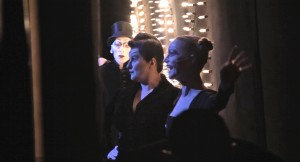TRIBECA REVIEW: ‘BAM150’

The Brooklyn Academy of Music is one of the preeminent institutions of theatrical art in the world. The network of venues, including an opera house, theater, movie theaters and more, is like a watering hole for traveling circuses and caravans of touring theatrical companies. The greatest actors of several generations have graced BAM’s stages, and the success doesn’t appear to be slowing. As I write this review, Jonathan Pryce is camped out at BAM’s Harvey Theatre, offering a celebrated performance in a Harold Pinter play. He follows in the footsteps of Kevin Spacey in Richard III, Cate Blanchett in A Streetcar Named Desire and a multitude of productions featuring dazzling theatricality (many with no celebrity casting).
Unlike its sister community in Manhattan, BAM is dedicated to adventurous risk taking. Occasionally, the arts institution furrows some brows, but its track record is solid. If you buy a ticket to a BAM show, there’s a good chance of having your mind blown.
The icing on the cake for BAM’s storied history of 150 years is a documentary that looks back at the many triumphs. BAM150, directed by Michael Sládek and recently featured at the Tribeca Film Festival, has an uncanny ability to never come across as self-indulgent. There’s never a feeling of these performers and crew members sticking their nose up into the air and acting like “artistes.” Instead, the documentary is able to showcase the sense of community that exists among all the people who call BAM home (whether temporarily for a few performances or over many years).
Many voices emerge in the documentary, including Peter Brook and Laurie Anderson, among several other artists who used BAM as a Petri dish in the 1970s and 1980s when Harvey Lichtenstein served as president. This man, now retired, ushered in a wave of creativity to Brooklyn, never worrying about how the audience might react to a particular theatrical, dance or musical display. The end result of his daring efforts is a long legacy of entertainment, education and engagement.
In recent years, BAM continues to thrive under the direction of Joseph V. Melillo (executive producer) and Karen Brooks Hopkins (president). The two leaders have continued Lichtenstein’s success and added many new programs for the public. Some may quibble at the overly corporate nature of today’s BAM, with gala events, Hugh Jackman photo shoots and company sponsorships, but there’s still no denying that the proof of this institution’s excellence can be found on stage. BAM knows how to bring the goods time and time again.
Sládek’s documentary embraces BAM’s history and never challenges any of the assumptions. But the filmmaker doesn’t stray from the institution’s darker days, when financial difficulty almost closed the doors for good. His camerawork is slick and often beautiful. He gains access to many productions — including The Threepenny Opera from the Berliner Ensemble — from all angles, whether backstage, in the lobby or on the tour bus with the performers.
One of the true highlights of the Tribeca Film Festival, BAM150 is a loving tribute to a New York institution that deserves the highest praise.
By John Soltes / Publisher / John@HollywoodSoapbox.com
-
BAM150
-
2012
-
Directed by Michael Sládek
-
Running time: 86 minutes
-
Click here for more information.
-
Rating:





